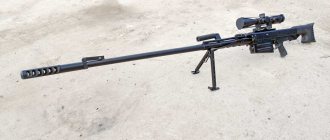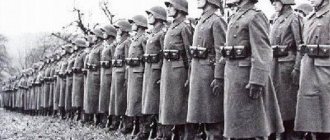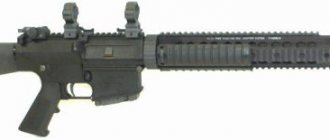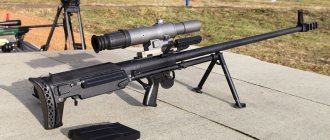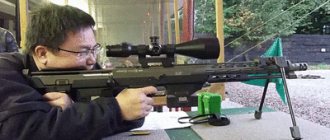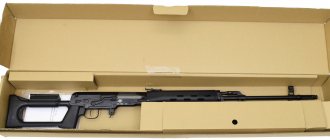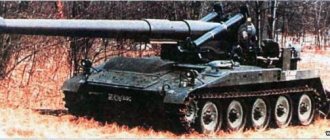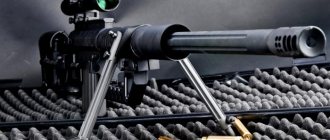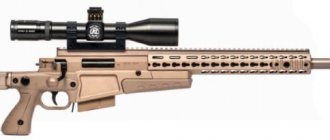Recently, the popularity of large-caliber sniper rifles (KSV) has been rapidly growing. Rumor ascribes absolutely fantastic qualities to this weapon: you can accurately hit the enemy’s head from 2000 meters, and it’s easy to deal with the enemy’s armored vehicles. Let's try to understand this category of small arms, taking a large-caliber sniper complex from one manufacturer for description.
This manufacturer will be the famous American company Barrett Firearms and its famous M82 rifle. This weapon can easily be called the most famous and popular in its class. The sniper complex was born in 1982. The rifle is in service in several dozen countries around the world. Currently, the Barrett M82 or M107 is considered the most powerful sniper rifle in the world.
This sniper system has a caliber of 12.7 mm and is designed not only to combat enemy personnel, but also to destroy his light armored vehicles, radars, aircraft and helicopters in parking lots, as well as to combat enemy snipers. This rifle is also called anti-material. It was truly created to destroy enemy equipment and materiel.
M82 rifle - history of creation
In 1982, retired US police officer Ronnie Barrett created perhaps the most famous rifle in a makeshift weapons workshop in his garage. But popularity did not come to it right away - such companies as Winchester Arms and Fabrique National refused to purchase rifle drawings, and at first the US Army also refused to buy “homemade” designs.
However, the designer did not despair and began small-scale assembly and sale of the Barrett M2 rifle on the American market. In 1986, Ronnie incorporated Barrett Firearms and took his place in the US trade niche with the M82A1 Barrett rifle. Only after this, the new weapon was noticed in the American army, and for the upcoming Operation Desert Storm, about three hundred rifles were purchased as experimental sniper weapons.
In 1987, Ronnie Barrett patented the design of his rifle.
Based on the results of Operations Desert Storm and Desert Shield, the M82A1 rifle was adopted by the army, and in 1992, another three hundred copies of the rifle were purchased by the US Marine Corps. Since that time, the Barrett sniper rifle in various modifications has been in service with the army almost continuously.
Barrett M82 / M82A1 / M82A1M / M82A2 / M82A3 / M107 sniper rifle
The main purpose of the Barrett M82 series anti-material rifle is the destruction of enemy materiel and military equipment, including cars, communication and radar cabins, aircraft and helicopters in parking lots. Their other important role is to destroy unexploded ordnance from a safe distance.
The M82 large-caliber sniper rifle was created by former law enforcement officer, 28-year-old American Ronnie Barrett. The self-taught inventor constructed the first working version of the rifle in his basement garage workshop in 1982 (hence the name M82).
| Barrett M82 early version |
After unsuccessful attempts to sell his rifle design to several world famous arms companies such as Winchester and Fabrique National, Ronnie Barrett began to engage in small-scale assembly and sale of rifles in the US domestic market and by 1986 founded the production of his rifle, by that time slightly modernized and received designation M82A1, and in 1987 Barrett received a patent for his invention.
| Barrett M82A1 early version with cylindrical muzzle brake |
| Caliber, mm | 12.7×99 (.50 BMG) |
| Length, mm | 1220 855 (model CQ) |
| Barrel length, mm | 737 508 (model CQ) |
| Weight without cartridges, kg | 12.9 |
| Initial bullet speed, m/s | 855 |
| Magazine capacity, no. cartridges | 10 |
| Effective firing range, m | 1800 |
The first serious success came to Barrett Firearms in 1989, when the Swedish Army purchased about 100 M82A1 rifles. The rifle's real acceptance began in 1990, when the US military purchased significant numbers of M82A1s during Operations Desert Shield and Desert Storm in Kuwait and Iraq, respectively. Approximately 125 rifles were initially purchased by the US Marine Corps, followed by orders from the US Army and Air Force. According to press reports, the M82A1 was also used by US Navy SEALS special forces against Iraqi forces in the Persian Gulf, and already in 1992, the Marine Corps and US special operations forces purchased 300 M82A1 units. Subsequently, the number of orders constantly increased.
| Barrett M82A1 |
The Barrett M82A1 received the designation SASR - “Special Applications Scoped Rifle” in the American Army. "special purpose rifle with optical sight."
Since the start of mass production, the Barrett M82 rifle has been modified several times:
Barrett M82A1 - the first modification known as the "Light Fifty".
This model appeared in 1986 and had several minor modifications in the design. It was on the M82A1 that muzzle compensators, characteristic of all Barretts, were introduced. Barrett M82A2
Barrett M82A2 during firing
The Barrett M82A2 is a “radically” modified model, made according to the “Bullpup” scheme. The M82A2 was developed in 1987 specifically for use against highly mobile targets and as a low-cost anti-helicopter weapon (the "standard" models are designed to engage ground targets). Shooting was supposed to be carried out only from the shoulder in order to reduce recoil, so the magazine receiver, equipped with a special lining, was used as a shoulder rest, and the pistol grip was moved far forward, as was the optical sight. An additional front handle has been added for ease of holding. However, this option was quickly discontinued due to lack of demand.
Barrett M82A1M is a modified version of the M82A1. The modification was made according to the standards adopted by the American army. The new model received open sighting devices (in case of failure of the main optical one), a “Picatinny” guide allowing the installation of sighting devices of various classes, a removable carrying handle, and in addition, an additional folding bipod appeared under the butt of the weapon, providing better stability of the weapon when shooting.
| Barrett M82A1M |
Barrett M82A3 - modification for the US Marine Corps. It differs from the Barrett M82A1M in the absence of an additional bipod under the butt and a fixed carrying handle, which can be mounted on a Picatinny rail. The mechanism and barrel of the rifle were slightly lightened, and the muzzle brake was also redesigned.
| Barrett M82A3 |
The Barrett M107 (M82A1/M107) is essentially a model of the M82A1M, but with minor technological changes designed to improve the reliability of the rifle.
| Barrett M107 |
Barrett M107CQ (M82A1/M107CQ) – a variant intended for use on helicopters and armored vehicles; the main difference from the basic version is the barrel shortened by 9 inches (508 mm versus 737 mm for the full-size model).
| Barrett M107CQ with short barrel |
In addition, on the basis of the M82A1, a prototype of a new weapon OSW (Objective Sniper Weapon) was created, which is an M82A1 re-barreled for a 25 mm shot from the promising OCSW automatic grenade launcher. The experimental rifle showed increased effectiveness against all types of targets, but the recoil during shooting turned out to be almost unbearable for an ordinary shooter.
Barrett M82A1 main parts and mechanisms
The M82 series sniper rifles are built on the basis of automatic weapons with a short barrel stroke. Locking the barrel is done by turning the bolt to 3 lugs. After the shot, the barrel, rigidly locked by the bolt, rolls back 25 mm, then the pin on the bolt, interacting with a figured cutout in the bolt frame, causes the bolt to turn and unlock the barrel. After this, the barrel “runs” onto the accelerator lever, which transfers the recoil energy of the barrel to the bolt frame, causing the bolt to open. The barrel stops and the bolt removes and ejects the spent cartridge case. The barrel returns to the forward position under the action of its return spring. The bolt, under the action of its own return spring, comes to the forward position, along the way sending a new cartridge from the magazine into the barrel, and then locks the barrel. The firing pin is cocked by placing it on the sear as the bolt moves forward.
Thanks to this system, the recoil impulse when firing is significantly reduced, which, coupled with the use of a muzzle compensator of the original design, made it possible to reduce the recoil of the weapon, which in turn had a positive effect on the accuracy of fire and the durability of the rifle itself.
The trigger mechanism is striker type, single fire mode only. Extraction of spent cartridges is carried out through a window on the right side of the receiver.
The receiver is made of two detachable halves (upper and lower), stamped from sheet steel and connected by transverse pins. The magazine neck, pistol grip and folding bipod are attached to the lower half of the receiver, and mountings for an optical sight and a folding carrying handle are attached to the upper half. The back of the lower receiver is used as a stock and is equipped with a rubber butt pad.
The barrel is massive, with longitudinal valleys for lightness and improved cooling, and is equipped with an effective muzzle brake to reduce recoil.
The muzzle brake is an original two-chamber design that absorbs up to 30 percent of recoil. However, this design of the compensator does not hide the flame of the shot, which is a strong unmasking factor.
Barrett M82A1 on a tripod
The rifle is equipped with folding open sights and a mount for an optical and night sight, usually with a 10X magnification.
The rifle is fed with cartridges from detachable box magazines with a capacity of 10 rounds.
The rifle is equipped with a bipod, identical in design to the bipod of the M60 machine gun. In addition, on the lower part of the receiver there are special mounts for installing the rifle on infantry machine-gun tripods of the M3 or M122 type; also, using a special shock-absorbing cradle, the rifle can be mounted on equipment (jeeps, armored personnel carriers).
The rifle has sling swivels, but carrying it on a belt is difficult due to the large length and weight of the weapon. The rifle is transported in special soft or hard cases.
| Barrett M82A1 in carrying case |
The accuracy of the rifle is about 1.5 - 2 arc minutes (1.5 - 2 MOA) when using match class cartridges.
The Barrett M82 series rifles are in service with Army and police units in more than 40 countries around the world. Primary users include the Army, Marine Corps, US Coast Guard, Military and Special Forces Police of Belgium, Chile, Denmark, Finland, France, Germany, Greece, Israel, Italy, Mexico, the Netherlands, Norway, Philippines, Portugal, Saudi Arabia, Spain, Sweden, Turkey, Great Britain.
Barrett Large Bore Rifles
All rifle models in this line have minor differences. The design of the rifles allows disassembly and maintenance of weapons in the field and without the use of special tools.
- M82 - the first model with a rotating bolt, did not have sights;
- M82A1 – a modified rifle with an improved muzzle brake;
- М82А1А – modification of M82A1 chambered for Raufoss Mk 211 cartridges (Norwegian 12.7x99 mm);
- М82А1M – the final modification of the M82A1, with an installed open sight, a Picatinny rail, as well as an additional bipod for the butt, which increases the accuracy of the shot;
- M82A2 – modification for firing at low-flying lightly armored air targets (helicopters). It was assembled using a bull-pup layout, where the magazine receiver is located behind the pistol grip. In this model, the magazine receiver is combined with a shoulder rest, so that shooting is possible only from the shoulder - it is conceived as an inexpensive alternative to man-portable anti-aircraft missile systems;
- M82A3 - variant for the US Marine Corps, devoid of an additional rear bipod, as well as a portable handle;
- Barrett M107 - a modified version of the M82A1, improvements were made to the recoil damping system, a carrying handle appeared on the butt, and the design of the monopod under the shoulder rest was improved;
- M107CQ is a nine-inch (23 cm) shortened version of the M107 rifle, designed for firing from vehicles (armored personnel carriers, helicopters) on the move. By shortening the Barrett 50 BMG barrel, the rifle's weight was reduced by five pounds;
- OSW (Objective Sniper Weapon, Barrett XM109) is an experimental model of a 25-mm grenade launcher based on the M107. Thanks to its unique design, it can be converted into a rifle and back.
Disassembly procedure
- Remove the mounting pins, which are equipped with rings for convenience. The first bolt is located at the bottom of the forend in front of the magazine hopper, the second is located above the butt plate of the shoulder rest.
- Lift the rear of the receiver with the barrel and receiver, then remove it completely.
- Retract the bolt carrier and remove the bolt return mechanism mounting pin. Then remove it from the receiver and remove the spring from the bolt body.
- Remove the pins securing the barrel return spring, remove it from the housing, remove the springs.
- Remove the bipod.
Assembly is carried out in reverse order
Design features
The Barrett M82A1 rifle is self-loading; the barrel bore is locked when the bolt is turned by means of three lugs in the grooves of the receiver. The rifle barrel is made using cold forging and is equipped with a removable muzzle brake-recoil compensator. If necessary, instead of a DTK, a muffler can be installed on the barrel, which significantly increases the length of the weapon.
The Barrett large-caliber rifle or Barrett M82A1 can be mounted on various racks, including the M122 racks used on light wheeled vehicles.
In combat, ammunition is fed from detachable box magazines with a capacity of ten rounds. Magazines are produced by stamping from steel sheets. The effective firing range of the M82 Barrett rifle is 1800 meters when using standard 12.7x99 mm (.50 BMG) cartridges.
Thanks to the Picatinny rail, any sighting devices can be installed on the Barret m82a1 - from the simplest ring-type optical sights to high-precision sniper sights with many settings and a ballistic calculator.
The main purpose of the rifle is to fire at lightly armored enemy vehicles, but in practice the rifle is most often used for shooting at manpower protected by light shelters (for example, walls made of adobe).
Description of the rifle
The M82 is a self-loading rifle, the automation of which operates on the principle of a short barrel stroke. Under the influence of powder gases, the barrel together with the bolt moves back, turns and unlocks the barrel bore. He removes the spent cartridge case, moving forward under the action of the return springs, the bolt sends the cartridge into the chamber and closes the barrel.
This principle of automatic operation significantly reduces the recoil of weapons that use a very powerful 50-caliber cartridge. However, this was not enough, Barrett turned his attention to the muzzle brake-compensator and began trying various designs. He wanted to find a middle ground between reducing the recoil impulse and affecting the ballistics of the bullet. As a result of his search, a compensator with a characteristic arrow-shaped shape was born. The rifle is equipped with a standard Ultra MZA optical sight from LeupoLd & Stevens with a tenfold magnification; the M82A1M modification also has open sights. The rifle magazine has a capacity of 10 rounds.
50-caliber cartridges (12.7×99 mm) are used for shooting. You can use regular machine gun ammunition, but then the shooting accuracy will be lower. When using special ammunition, the accuracy of the rifle is 1.5-2 MOA. In ordinary language, the deviation from the aiming point will be approximately 20-30 cm at a distance of 500 meters. Even if this is not the most ideal option for a sniper weapon, do not forget that the M82 was designed to combat enemy equipment.
It should be noted that these rifles are leaders in long-range shooting accuracy. There are known facts of defeating the enemy at a distance of more than two kilometers (2300 meters). The use of the M82 changed the tactics of American ground units. Now they can occupy a commanding height and destroy the enemy from a great distance without entering into close combat. A special bullet can penetrate 30 mm thick armor or a 30 cm wall.
